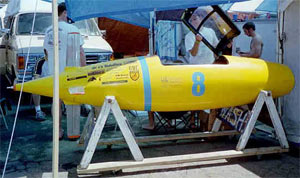
 | One Summer afternoon in 1999, I got a phone call from someone recruiting volunteer Judges for a Human Powered Submarine Race. I suggested that since I didn't know anything about submarines, maybe someone else would be better, and that I would be happy to call around. I asked when the contest would be, and the answer was tomorrow morning. I allowed that maybe I was as good as anyone, and enjoyed watching the contest. |
| A few months later, some UCSD engineering students came to the executive meeting of the San Diego Section of the American Society of Mechanical Engineers. They gave a presentation, explaining that it was hard enough to design, build, and race submarines, and would the ASME consider running the actual Submarine contests between universities? | 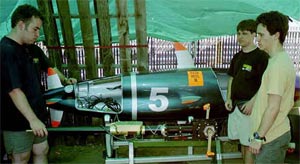 |
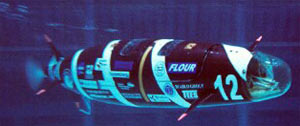 | I had long believed that engineering contests, where one person or a team designs, builds, and operates some machine, are an excellent adjunct to a traditional engineering education. It's one thing to read a book about stress and do some calculations, but another thing entirely when you see if those calculations lead to a part that breaks under actual use. Additionally, engineering involves working with big teams of people, keeping project schedules and budgets, and a host of other things that are barely mentioned in a typical university engineering curriculum. |
| Some like minded individuals and I formed a commitee and organized our first contest. It was held in the summer of 2000, and we called it HPS2000. To ensure that the engineering students would learn as much as possible, we had judges who would talk with the students about their engineering processes and give awards, and we had the students give speeches about their projects. | 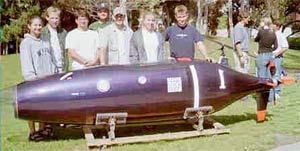 |
 | The submarines are flooded with water, and the drivers breath using SCUBA gear. Obviously, there is the danger of crashing, drowning, etcetera, so we took a lot of safety precautions. See in the various pictures that every submarine is marked with flourescent paint everywhere a rescuer needs to operate a hatch, etc. to rescue someone, and everywhere a fin or propeller might tangle up in a rope or net. |
| We also recruited dozens of safety divers, who were submerged throughout the tank, watching all the time and ready to rescue should any problem occur. Fortunately there were few problems. At right, see a meeting of the safety divers before the race, where Rich, our divemaster, is explaining all the race protocols, how and when to conduct rescues, and etcetera. | 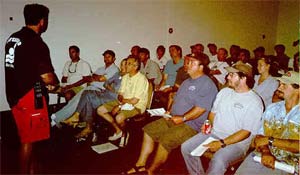 |
 | Here, a submarine has overshot the course and tangled in the net which keeps them from crashing into the end of the basin. Safety divers (pink hats) are disentangling the submarine. Additional staff watch from the side in case other assistance is required. |
| Here, UCSD's submarine is underway and passing through the 10 meter timing trap. In the lower right corner is a television camera that is part of the system that times the submarines accurately enough to document world record speeds. Two Guiness World Records were set at our events. | 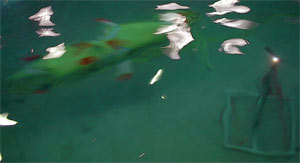 |
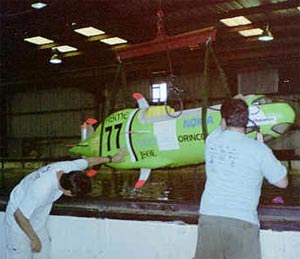 | There were all kinds of things to organize, like shipping submarines from all over the United States and Canada, to renting the Offshore Model Basin and having food, drink, and restrooms available, to deciding who got to use the tank when, to having all kinds of race timing and scuba gear and compressed air available. Here, our staff is moving UCSD's submarine into the basin using a crane. |
| Here's a trophy Jon K. and I cast for HPS2006. It's aluminum and several pounds. There were a lot of plaques for awards, volunteers, and sponsors, so Jon and I roasted in the Georgia summer sun many a Saturday to finish our foundary work. | 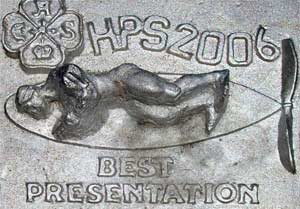 |
 | Teams were required to make design 15 minute presentations. Judges awarded prizes for the quality of the presentations. |
| This Virginia Tech Submarine set a Guiness World Speed Record in 2004. It consists of a hard fairing over the head and torso of the operator, a Lycra sock over his legs, and a giant swim fin that attaches to both feet. A timing gate is visible, as is the yellow stripe on the basin bottom the drivers follow. | 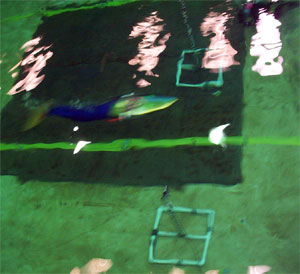 |
 |  |
For a Larger Layout Click Here.Team divers entered the tank at the upper left, and waited or prepared their submarines along the left wall. The starting line was at the lower left corner, and subs raced along the lower side, through the timing gates, hopefully stopping before the net at the right end. They returned to the starting area along the upper side. In the middle of the upper side, there were cranes to take the submarines in and out of the basin. |
 | 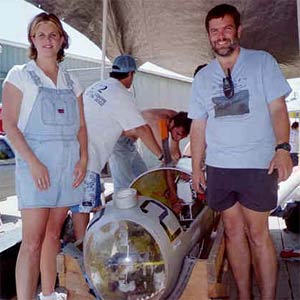 |
 |  |
| We wrote an ASME paper to explain all the lessons we had learned about running design contests, Considerations for Planning and Running Educational Engineering Contests. Read it if you're interested. | 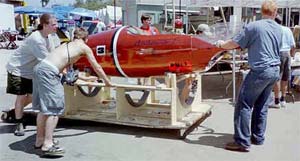 |
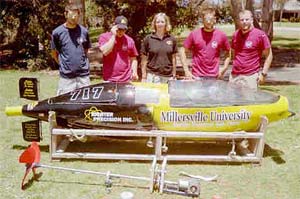 | 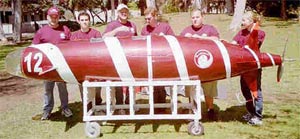 |
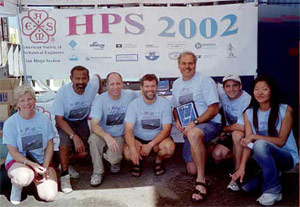 |
| This are the wonderful people who organized HPS2002. From left, they are Ellen (Safety Divers), Nip (Sponsors and Food), Rob (Safety and Logistics), me (Contestants and Chairman), Tom (Underwater Equipment), Paul (Race Coordination), and Ji (Press Relations). They all did a fantastic job, as did hundreds of volunteers and dozens of contestants. I'd like to thank the Volunteers and Contestants of HPS2000, HPS2002, HPS2004, and HPS2006. It was great fun and much was learned by all. |